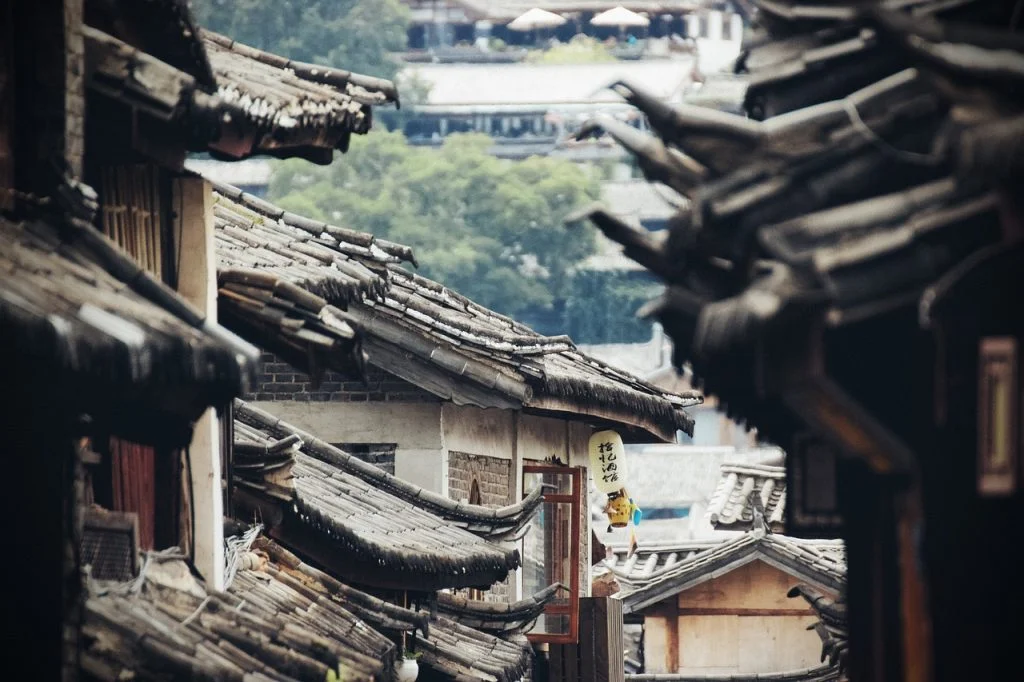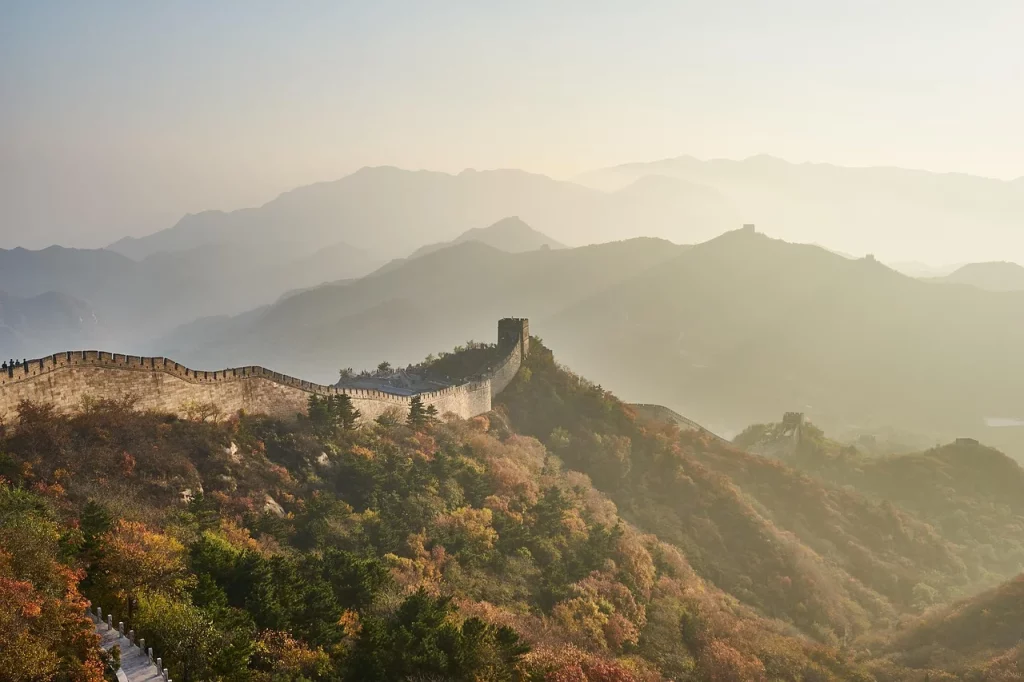Welcome to the fascinating world of China! A land where dragons are as revered as pandas are cuddly, where the Great Wall stretches farther than your last terrible blind date, and where tea isn’t just a beverage, it’s a national pastime.
Ever wondered why China is obsessed with the color red? Well, it’s not because they ran out of other crayons. It’s steeped in tradition, much like their famous green tea. From the dizzying heights of Shanghai’s skyscrapers to the ancient echoes of the Terracotta Army, each fact will be like opening a fortune cookie.
China is a sleeping giant. Let her sleep, for when she wakes she will move the world.
Napoleon Bonaparte
China Facts
Prepare to unravel the intriguing threads of China’s history, a blend of ancient traditions and rapid modernization. Stay focused and read thoroughly because a quiz at the bottom of the article awaits to test your knowledge about Chinese culture!
- China is the world’s most populous country, with over 1.4 billion people.
- The Great Wall of China is over 13,000 miles long, making it the world’s longest wall.
- China is considered the birthplace of tea, which was discovered around 2737 BC.
- The Chinese New Year celebration lasts for 15 days, ending with the Lantern Festival.
- China’s high-speed rail network is the largest in the world, spanning over 22,000 miles.
- The Forbidden City in Beijing is the world’s largest imperial palace, with over 9,000 rooms.
- Pandas, native to China, are considered a national treasure and a symbol of peace and friendship.
- China’s Yangtze River is the third-longest river in the world, stretching over 3,900 miles.
- The Terracotta Army, discovered in 1974, consists of thousands of life-sized clay soldiers.
- China is the world’s largest producer and consumer of rice.
- The Chinese zodiac is based on a 12-year cycle, with each year associated with an animal sign.
- Mount Everest, the world’s highest mountain, is located on the border between China and Nepal.
- The Shanghai Tower in Shanghai is China’s tallest building and the second-tallest in the world.

- The ancient Chinese invention of gunpowder led to the creation of fireworks and firearms.
- China’s Huangguoshu Waterfall is one of the largest waterfalls in Asia, measuring 255 feet high.
- The Chinese language has over 50,000 characters, though a few thousand are commonly used.
- The Qingming Festival is a traditional Chinese event for commemorating ancestors.
- China is a leading country in the use of solar energy and green technology.
- The Chengdu Research Base in Sichuan is famous for its conservation efforts for giant pandas.
- China’s Internet censorship system is one of the most extensive in the world.
- Acupuncture and traditional Chinese medicine have origins dating back thousands of years.
- The Yellow Mountains are known for their scenic beauty, peculiarly shaped granite peaks, and pine trees.
- China has the world’s largest standing military force.
- The Three Gorges Dam on the Yangtze River is the world’s largest hydroelectric power station.
- China’s Mid-Autumn Festival is celebrated with mooncakes and is also known as the Moon Festival.
- Ping Pong (Table Tennis) is considered the national sport of China.
- The Chinese martial art known as Kung Fu originated over 4,000 years ago.
- The Silk Road was an ancient network of trade routes connecting China to the Mediterranean.

- China’s Hainan island is often referred to as the “Hawaii of China” due to its tropical climate.
- The Confucianism philosophy, founded by Confucius, has deeply influenced Chinese culture and society.
- Dragon Boat Festival is celebrated by racing dragon boats and eating zongzi, a type of rice dumpling.
- China is one of the world’s oldest civilizations, with a history dating back over 4,000 years.
- The Sichuan province is famous for its spicy cuisine, including the popular Sichuan hotpot.
- China’s Belt and Road Initiative is a global infrastructure development strategy.
- The Harbin Ice Festival features spectacular ice sculptures and is one of the largest of its kind in the world.
- China’s one-child policy was implemented in 1979 and relaxed in 2015 to allow two children.
- Chinese calligraphy is a revered art form, traditionally done with brush and ink.
- The Shenzhen Stock Exchange is known for its futuristic building design and is a financial hub in China.

- Mao Zedong, the founding father of the People’s Republic of China, led the country from 1949 until 1976.
- China’s Maglev Train in Shanghai is one of the fastest commercial high-speed trains in the world.
- The Yellow River, also known as the Huang He, is the second-longest river in China.
- China’s Alipay and WeChat Pay are among the world’s leading mobile payment platforms.
- The Chinese opera is a traditional performing art, known for its elaborate costumes and makeup.
- Karst landscapes in Guilin and Yangshuo are famous for their unique and picturesque hills.
- The Leshan Giant Buddha is the largest stone Buddha statue in the world, carved into a cliff face.
- China’s gaokao is a highly competitive national college entrance examination.
- The Wulingyuan Scenic Area in Hunan province features thousands of sandstone pillars and is a UNESCO World Heritage Site.
- China’s ecommerce market is the largest in the world, dominated by platforms like Alibaba and JD.com.
- The Yungang Grottoes are ancient Buddhist temple grottoes near Datong city, famous for their large statues.
- The Zhongnanhai compound in Beijing serves as the central headquarters for the Communist Party of China and the State Council of the People’s Republic of China.
China Myths

Having explored a good amount of interesting facts about China, it’s time to step into the reals of the myths. Let’s see what the actual truth is behind them.
- China Is a Monolithic Culture
China is incredibly diverse, with 56 recognized ethnic groups, each with its own unique traditions, languages, and cultures. It’s a melting pot of customs and histories. - Chinese Food Is All About Rice and Noodles
Chinese cuisine is vastly diverse, with regional variations like spicy Sichuan dishes, Cantonese dim sum, and much more. It’s a rich culinary tapestry far beyond just rice and noodles. - China’s Cities Are All Overcrowded and Polluted
While some cities face challenges, China also boasts beautiful landscapes, pristine rural areas, and cities with advanced environmental policies. It’s a country of contrasts. - Mandarin Is the Only Language Spoken in China
Mandarin is the most spoken language, but China is home to over 200 individual languages and dialects, reflecting its vast cultural diversity. - China Is Technologically Backward
China is at the forefront of many technological advances, leading in areas like renewable energy, high-speed rail, and digital technologies. It’s a hub of innovation and progress.
No products found.
China Quotes

Here are some of my favorite quotes attributed to various thinkers, leaders, and historical figures. Let me know which one is your favorite, and feel free to add yours in the comment section so I can add it to the list.
In China, everything is possible, but nothing is easy.
Unknown
This anonymous quote reflects the complexity and potential of China, highlighting the challenges and opportunities it presents.
China has a deep-rooted culture that goes back thousands of years. That’s what makes it interesting.
Bill Gates
Bill Gates comments on the rich, ancient culture of China and its appeal due to its extensive history.
The Chinese use two brush strokes to write the word ‘crisis.’ One brush stroke stands for danger; the other for opportunity.
John F. Kennedy
John F. Kennedy’s quote interprets a Chinese linguistic concept, suggesting that the crisis in China is viewed both as a risk and a chance for new possibilities.
The people of China are friendly and hardworking, with an enduring spirit.
Howard Schultz
Howard Schultz, the CEO of Starbucks, praises the Chinese people for their friendliness, industrious nature, and resilience.
To understand the future, one must study the past; in China, the past and the future are always intermingled.
Henry Kissinger
Henry Kissinger reflects on the importance of China’s history in understanding its future, emphasizing the interconnectedness of the past and present in Chinese culture.
China FAQ

As we leave the quotes behind, we enter the most common question section. Read carefully because the quiz awaits you. Just a scroll away.
- Are China and Russia allies?
Yes, China and Russia have developed a strategic partnership, especially in recent years. They cooperate in various sectors, including defense, trade, and technology. However, this alliance is more of a strategic convenience than a formal alliance like those in NATO. - What is the significance of the Great Wall of China?
The Great Wall of China is a symbol of Chinese historical resilience and architectural ingenuity. Originally built to protect against invasions, it now stands as a UNESCO World Heritage site and a major tourist attraction, representing China’s long and rich history. - How does China’s economy compare globally?
China has the world’s second-largest economy by nominal GDP. It’s a global hub for manufacturing and is rapidly growing in the technology and service sectors. China’s economic policies and growth have significant impacts on the global economy. - What are the major religions practiced in China?
China is religiously diverse, with Buddhism, Taoism, and Confucianism having historical significance. There’s also a significant population of Christians and Muslims. The Chinese government officially recognizes five religions: Buddhism, Taoism, Islam, Protestantism, and Catholicism. - What is the role of the Chinese language in the world?
Chinese, primarily Mandarin, is one of the most spoken languages globally. It’s not only significant culturally but also increasingly important in international business and diplomacy. Learning Chinese can open doors to understanding the rich Chinese culture and engaging in global commerce.
No products found.
China Trivia

Welcome to the Ultimate China Quiz! Brace yourself, because if you don’t get a single answer right, you’ll be ceremoniously appointed as the honorary guardian of the Great Wall – one brick at a time!
Conclusion
Our journey through the fascinating realm of China has concluded, and we find ourselves enriched with knowledge and more connected to this ancient and dynamic culture. From the Great Wall stretching across mountains to the rapid technological advancements in cities like Shanghai, China presents a tapestry of history and modernity, interwoven with unparalleled artistry.
It reminds us that every nation holds stories worth exploring and understanding. As you reflect on these facts, think about this: What aspect of China’s rich heritage resonates the most with you, and why? I’ll be happy to hear about it in the comments.
3 Sources Used For This ArticleChina Travel Guide: What To See, Do, Costs, & Ways To Save – Tourist Secrets
The grey wall of China: inside the world’s concrete superpower – The Guardian


